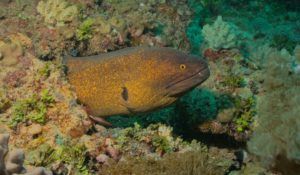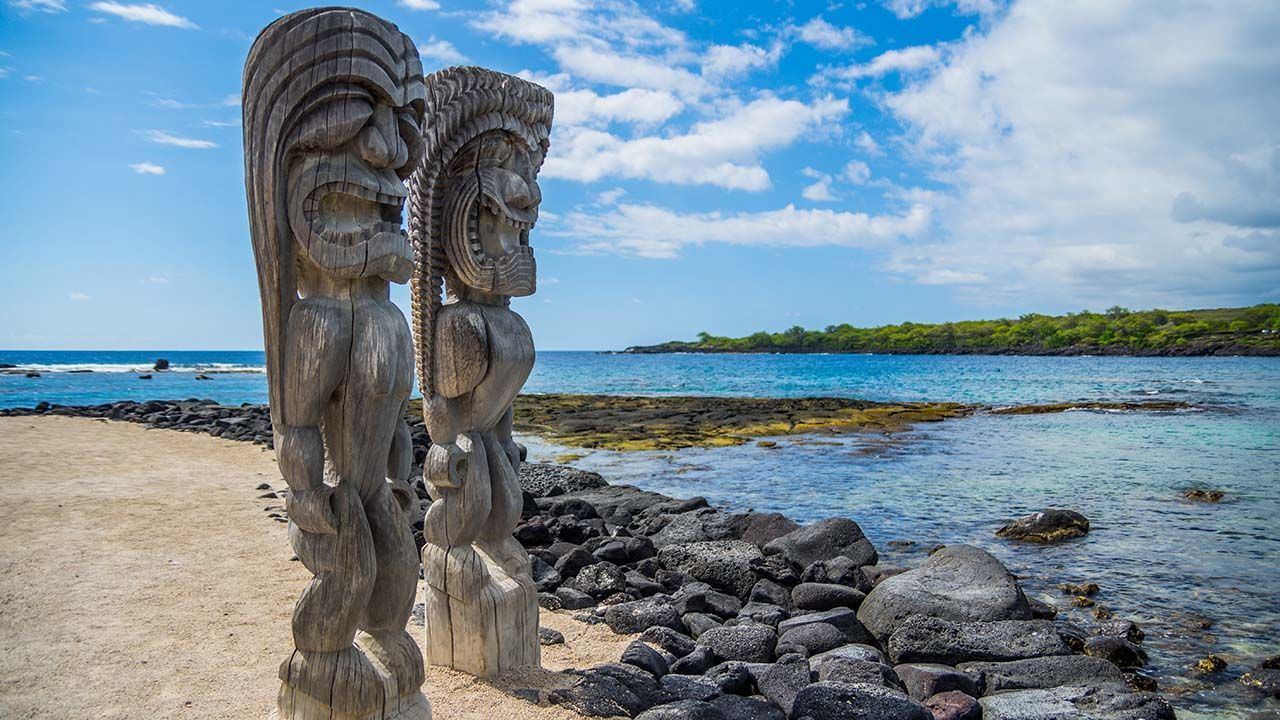Hawaii’s Eels and Eel-Like Fish: Moray, Conger, Snake, & More

The eels of Hawaii come in many shapes and sizes, but they all have one thing in common: they are all masters of disguise. These slippery creatures can be found in the ocean’s depths, lurking among the coral reefs and rocks.
There are three types of eels that are commonly found in Hawaii’s waters: the Moray, Conger, and Snake eel. Each has its own unique characteristics and habits. In this blog post, we will take a closer look at each of these eels and learn about their habits and habitats.
Hawaiian Moray Eel
The moray eel is a sinuous, secretive inhabitant of coral reefs in Hawaii. Growing up to 6 feet in length, these eels are not to be trifled with—they have sharp teeth and a powerful bite. Morays are nocturnal predators, stalking their prey in the dark crevices of the reef. When an unsuspecting fish swims by, the moray eel lunges out and grabs it with its powerful jaws. These eels are also known to eat crabs, octopuses, and even other moray eels!
Although they may look fierce, moray eels are actually shy creatures that pose little threat to humans. In fact, they are often more scared of us than we are of them! While they may not be the most cuddly animals on the reef, the moray eel is an essential part of the delicate ecosystem of Hawaii.
Moray Eels as Food
While moray eels are not typically considered to be a delicacy, they are eaten in some parts of the world. In Japan, for example, moray eel is served grilled or smoked. It can also be found in Chinese and Taiwanese cuisine. Moray eel is also sometimes used as bait for fishing. However, due to their potential size and aggression, these eels can be dangerous to handle. As such, it is generally advisable to leave them alone unless you are an experienced fisherman.
Notable Species:
- Yellowmargin Moray (Puhi paka) – A large eel with a yellow-tinted head.
- Whitemouth Moray (Puhi uha) – Easily recognized by its white interior mouth.
- Snowflake Moray (Puhi anuenue) – A smaller, boldly patterned eel popular in aquariums.
- Dragon Moray (Enchelycore pardalis) – Rare and vibrant, with a striking set of curved jaws.
Are Morays Dangerous?
Morays are not aggressive toward humans unless provoked. However, their bite can be severe due to their powerful jaws and backward-facing teeth. Avoid feeding or attempting to touch them.
Local Tip: Ancient Hawaiians both respected and feared the puhi. They were sometimes regarded as aumākua, or family guardians.
Hawaiian Conger Eel
The Hawaiian conger eel is a species of eel that is found in the waters around the Hawaiian Islands. These eels can grow to be around 1.5 feet, and they are typically brown or black in color. Conger eels are carnivorous, and they primarily feed on small fish and crustaceans. These eels are also known for their ability to change their skin color, which they do in order to camouflage themselves from predators.
Hawaiian conger eels are not considered to be a threatened or endangered species, but they are protected by the state of Hawaii. These eels are popular among both recreational and commercial fishermen, and they are considered to be good for eating.
Hawaiian Snake Eel
The Hawaiian Snake Eel is a species of eel that can be found in the waters around Hawaii. These eels are red or brown in color, and they can grow to just under three feet long. Hawaiian Snake Eels are carnivorous, and they typically feed on small fish, crustaceans, and worms. These eels are often found living in burrows that they dig in the sand. When hunting, Hawaiian Snake Eels will coil their bodies around their prey and constrict it until it suffocates.
These eels are not considered to be dangerous to humans. However, if they are provoked, they may bite. Hawaiian Snake Eels mate during the summer months. The female eel will lay a batch of eggs, which the male eel will then fertilize. The eggs will hatch after about two weeks, and the young eels will be on their own from that point on. Hawaiian Snake Eels can live for up to ten years in the wild.
Despite their name, snake eels aren’t snakes—they’re fish that mimic both eels and snakes in appearance. Many species bury themselves in the sand with only their heads visible.
- Commonly Seen: The spotted snake eel, which can resemble a sea snake (note: Hawaii has no sea snakes).
- Behavior: Nocturnal, they feed on crabs and shrimp by ambushing from beneath the sand.
What’s the Difference Between Eels and Eel-Like Fish?
Before we explore Hawaii’s underwater residents, it’s important to understand the distinction between true eels and eel-like fish.
- True eels belong to the order Anguilliformes, characterized by their elongated bodies, lack of pelvic fins, and continuous dorsal and anal fins.
- Eel-like fish may look similar but belong to different families or orders. They’ve simply evolved similar shapes to navigate tight reef spaces, a phenomenon known as convergent evolution.
Eel-Like Fish in Hawaiian Waters
Some fish just look like eels but belong to completely different families. Here are a few commonly mistaken eel imposters.
Wolf Eels (Anarrhichthys ocellatus)
Despite the name, wolf eels aren’t true eels—they belong to the wolffish family. They are rare in Hawaii, preferring cooler, northern Pacific waters, but occasional sightings by deep divers off the Big Island have occurred.
Gunnels and Blennies
While not considered “eels,” some gunnel fish and large blennies have elongated bodies that make them easy to mistake for juvenile eels. They are much smaller, often less than a foot long, and live in tide pools and rocky shallows.
Eel Behavior and Ecology in Hawaii
Nocturnal Predators
Most Hawaiian eels, especially morays, are night hunters. They spend the day in tight crevices and emerge at dusk to hunt fish, octopuses, and crustaceans.
Smell Over Sight
Eels have poor eyesight but a keen sense of smell. They can detect trace scents in the water, making them highly effective predators.
Ecosystem Role
Eels are vital reef predators. By keeping populations of small fish and invertebrates in check, they help maintain a healthy reef ecosystem.
Are Eels a Threat to Swimmers and Snorkelers?
In general, eels are shy, solitary creatures that want nothing to do with humans. Bites are rare and typically result from human provocation, such as:
- Reaching into holes or reef crevices.
- Attempting to feed or handle an eel.
- Startling one while swimming near its hiding place.
If bitten, seek immediate medical attention to avoid infection or tissue damage.
Pro Tip for Snorkelers: If you see an eel, observe from a respectful distance and never try to touch it. Enjoy the moment—these creatures are a rare sight!
Hawaiian Cultural Significance of Eels
In Hawaiian mythology, eels are deeply symbolic. Some stories describe eels as shapeshifting gods, while others link them to family spirits or protectors known as aumākua.
One of the most famous legends involves Kāne and Kanaloa, the gods of creation, who were said to have transformed into eels during journeys across the islands.
Some families refrained from eating eel out of reverence, while others prized it as a delicacy.
Are Eels Safe to Eat in Hawaii?
Yes, eel is traditionally eaten in Hawaii and across the Pacific. However, not all eels are edible, and ciguatera poisoning is a risk with some larger reef predators.
- Commonly Eaten: Conger eels and freshwater eels are used in local and Japanese-style dishes.
- Not Recommended: Moray eels, due to their diet and higher risk of ciguatera.
If you’re not sure, it’s best to avoid consuming wild-caught eels unless sourced from a reputable vendor.
Tips for Spotting Eels While Snorkeling or Diving
Want to catch a glimpse of Hawaii’s elusive eels? Here are some tips:
Look in the Right Places:
- Shady reef holes and coral heads.
- Beneath rocks and ledges.
- Sandy flats (for buried snake eels).
Go at the Right Time:
- Early morning or late afternoon.
- Night dives offer the best chance to see active eels hunting.
Use Caution:
- Never stick your hand in a crevice.
- Give eels plenty of space.
- Avoid shiny jewelry that can be mistaken for fish.
Popular Places to Spot Eels in Hawaii
- Hanauma Bay (Oʻahu): Clear water and reef crevices make this a top eel-spotting location.
- Tunnels Beach (Kauaʻi): Great for snorkeling near the reef, where morays often hide.
- Kealakekua Bay (Big Island): Known for deeper snorkeling and occasional dragon moray sightings.
- Molokini Crater (Maui): A popular dive site where various eels and reef species live.
Frequently Asked Questions About Hawaii’s Eels
Q: Are there any dangerous eels in Hawaii?
A: While eels in Hawaii may look intimidating, they are generally not dangerous to humans unless provoked. The moray eel, which is the most common type, can bite if threatened—especially if someone tries to feed or touch it. The bite itself can be painful and may become infected, so it's best to admire these creatures from a respectful distance. Hawaii has no venomous eels.
Q: What should I do if I see an eel while snorkeling or diving?
A: If you encounter an eel underwater:
- Stay calm and avoid sudden movements.
- Do not attempt to touch or feed the eel.
- Observe quietly from a few feet away.
- Avoid reaching into crevices or holes where eels may be hiding.
Eels are often shy and will retreat if left undisturbed. Most negative interactions happen when people accidentally surprise them or behave recklessly.
Q: Do Hawaiian eels ever leave the water?
A: Almost all of Hawaii’s eels are fully marine creatures and do not leave the ocean. However, the freshwater eel (Anguilla marmorata)—which is rare in Hawaii—is capable of traveling between fresh and saltwater and has been observed moving across wet land surfaces between bodies of water. This species is more common in other parts of the Pacific.
Q: Are there freshwater eels in Hawaii?
A: Hawaii is home to a few freshwater eel species, most notably the Polynesian longfin eel (Anguilla marmorata). These eels are catadromous, meaning they live in freshwater streams but return to the ocean to spawn. You may spot them in the upper reaches of river systems like the Wailua River on Kauaʻi or ʻĪao Stream on Maui. These freshwater eels are highly elusive and rarely seen by casual visitors.
Q: Do Hawaiians eat eel?
A: Traditional Hawaiian diets included a wide range of seafood, and eel was sometimes consumed depending on the region and the family’s beliefs. Some Hawaiians considered certain eels sacred and refrained from eating them, especially if they were regarded as an aumākua (family guardian spirit). Today, freshwater eel dishes influenced by Japanese cuisine (such as unagi) are popular in restaurants, though locally harvested eel is less common.
Q: What’s the most unusual eel in Hawaii?
A: That title likely goes to the dragon moray eel (Enchelycore pardalis). With its fiery orange body, horn-like nostrils, and wickedly curved teeth, it looks like something out of a fantasy novel. It’s also one of the rarest eels to spot in the wild, usually found in deep reef systems. Divers who encounter one consider it a major highlight.
Q: Can you keep Hawaiian eels as pets?
A: Some smaller species like the snowflake moray are kept in home aquariums, but it’s essential to note that collecting marine life in Hawaii is heavily regulated. Permits are often required, and ethical considerations abound. Additionally, eels can be escape artists and require special tanks. Unless you’re experienced in marine aquarium care, it’s best to appreciate eels in their natural environment.
Q: Are eels active during the day?
A: Most eels, particularly morays, are nocturnal and do most of their hunting at night. During the day, they rest in reef holes and under ledges, often with just their head poking out. However, some species—like the snowflake moray—can occasionally be active in daylight, especially if they feel safe or are hungry.
Q: Are there sea snakes in Hawaii that look like eels?
A: No—there are no sea snakes in Hawaiian waters. If you see a snake-like creature while snorkeling, it's almost certainly an eel or a snake eel. While sea snakes are found in other parts of the Pacific, Hawaii is free of them, which often brings relief to visitors concerned about venomous marine life.
Avoid Eels While Snorkeling
While these eels are generally harmless, they can still give a painful bite if they feel threatened. For this reason, it’s best to avoid them altogether when snorkeling. Moray eels are perhaps the most feared of the three, thanks to their large size and sharp teeth. Observe them from a distance when seen in the water, and you will be just fine!
Enjoy Hawaii’s Marine Life From A Distance!
Now that you know more about some of Hawaii’s unique marine and reef life, you can go and enjoy snorkeling! Keep your distance from the wildlife while snorkeling, and enjoy your time in paradise!










